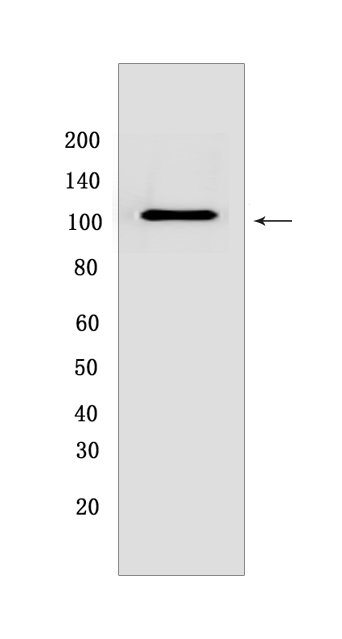PEG10/EDR Rabbit mAb [4914]Cat NO.: A49216
Western blot(SDS PAGE) analysis of extracts from HEK 293 cells.Using PEG10/EDRRabbit mAb [4914] at dilution of 1:1000 incubated at 4℃ over night.
Product information
Protein names :PEG10,EDR,KIAA1051e,MAR2,MART2,MEF3L1,RGAG3,PEG10_HUMAN,Retrotransposon-derived protein PEG10
UniProtID :Q86TG7
MASS(da) :80,173
MW(kDa) :100 kDa
Form :Liquid
Purification :Protein A purification
Host :Rabbit
Isotype :IgG
sensitivity :Endogenous
Reactivity :Human
- ApplicationDilution
- 免疫印迹(WB)1:1000-2000
- 免疫组化(IHC)1:100
- 免疫荧光(ICC/IF) 1:100
- The optimal dilutions should be determined by the end user
Specificity :Antibody is produced by immunizing animals with a synthetic peptide at the sequence of human PEG10/EDR
Storage :Antibody store in 10 mM PBS, 0.5mg/ml BSA, 50% glycerol. Shipped at 4°C. Store at-20°C or -80°C. Products are valid for one natural year of receipt.Avoid repeated freeze / thaw cycles.
WB Positive detected : HEK 293 cells
Function : Retrotransposon-derived protein that binds its own mRNA and self-assembles into virion-like capsids (PubMed:34413232). Forms virion-like extracellular vesicles that encapsulate their own mRNA and are released from cells, enabling intercellular transfer of PEG10 mRNA (PubMed:34413232). Binds its own mRNA in the 5'-UTR region, in the region near the boundary between the nucleocapsid (NC) and protease (PRO) coding sequences and in the beginning of the 3'-UTR region (PubMed:34413232). Involved in placenta formation: required for trophoblast stem cells differentiation (By similarity). Involved at the immediate early stage of adipocyte differentiation (By similarity). Overexpressed in many cancers and enhances tumor progression: promotes cell proliferation by driving cell cycle progression from G0/G1 (PubMed:12810624, PubMed:16423995, PubMed:26235627, PubMed:28193232). Enhances cancer progression by inhibiting the TGF-beta signaling, possibly via interaction with the TGF-beta receptor ACVRL1 (PubMed:15611116, PubMed:26235627, PubMed:30094509). May bind to the 5'-GCCTGTCTTT-3' DNA sequence of the MB1 domain in the myelin basic protein (MBP) promoter,additional evidences are however required to confirm this result (By similarity)..
Tissue specificity :Expressed in the cytotrophoblast layer but not in the overlying syncytiotrophoblast of the placenta. Expressed in prostate and breast carcinomas but not in normal breast and prostate epithelial cells. Expressed in the Hep-G2 cell line (at protein level). Expressed in brain, liver, spleen, kidney, thymus, lung, ovary, testis, reactive lymph node, skeletal muscle, adipose tissue and placenta. Expressed in pancreatic and hepatocellular carcinomas (HCC)..
Subcellular locationi :Extracellular vesicle membrane. Cytoplasm. Nucleus.
IMPORTANT: For western blots, incubate membrane with diluted primary antibody in 1% w/v BSA, 1X TBST at 4°C overnight.


